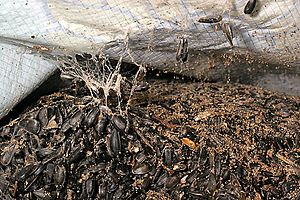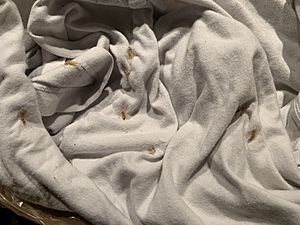Indianmeal moth facts for kids
Quick facts for kids Indianmeal moth |
|
|---|---|
 |
|
 |
|
| Scientific classification | |
| Synonyms | |
|
Many, see text |
The Indianmeal moth (Plodia interpunctella) is a small moth from the Pyralidae family. You might also hear it called the pantry moth, flour moth, or grain moth. It's often confused with other moths like the almond moth because they look similar and eat the same foods. This moth got its name because it was first seen eating "Indian meal," which was an old name for cornmeal. It doesn't actually come from India!
The young moths, called larvae or caterpillars, are sometimes called waxworms. But they are not the same as the waxworms sold as pet food. Indianmeal moths are a common pest found all over the world. They love to eat cereals, fruits, and other stored foods.
These larvae can even chew through plastic bags and cardboard boxes. This means they can get into food even if it seems sealed. Once you find them, these moths can be very hard to get rid of. The older larvae can travel far to find a place to turn into a pupa. So, where you find the moths might not be where they started. They can also hide and grow in clothes, so check your closets too!
Contents
Where Indianmeal Moths Live
The Indianmeal moth (Plodia interpunctella) lives on every continent except Antarctica. They prefer warm, tropical places. In the United States, they are very common in Florida because of the warm weather.
These moths can live in many different conditions. This makes them a very tough pest. You often find them in places where food is stored, like grain bins or warehouses.
About the Indianmeal Moth
The Indianmeal moth is the only known living species in its group, called Plodia. It is related to other moths like Cadra and Ephestia. These groups also include other pest moths, such as the Mediterranean flour moth.
The name "Indian-meal moth" was given by a scientist named Asa Fitch in the 1800s. He saw the larvae eating cornmeal, which people at the time called "Indian meal."
What Indianmeal Moths Look Like
Adult Indianmeal moths are about 8–10 mm long. Their wingspan is about 16–20 mm. The outer two-thirds of their front wings are usually reddish-brown with a shiny, copper look. They can also be bronze or dark gray. The inner part of their wings is yellow-gray or white-gray. There is a dark band where these two colors meet. Their back wings are usually plain gray.
The eggs of the Indianmeal moth are white, oval, and very tiny. You can barely see them without a magnifying glass. The newly hatched larvae are also hard to spot. They are mostly off-white with brown heads. They grow through five to seven stages, called instars. When fully grown, the larvae are about 12–14 mm long. They have three pairs of legs near their head and five pairs of soft, fleshy legs on their body. These legs help them move long distances to find a place to turn into a pupa.
What Indianmeal Moths Eat
Indianmeal moths eat many kinds of plants, grains, and human foods.
Plant-Based Foods
These moths eat a lot of plant-based foods. This includes dry pet food, birdseed, cereal, soup mixes, bread, pasta, rice, flour, spices, dried fruits, and nuts. They especially like wheat, sultanas, yellow corn, and almonds. Foods like groundnuts and maize meal make them take longer to grow.
Other Foods
Indianmeal moths are also known to eat other moth larvae, which is called cannibalism. However, this can spread a virus among them. Interestingly, they often choose to eat healthy larvae over sick ones. When given a choice, they tend to eat their own siblings rather than unrelated larvae.
How They Find Food
Indianmeal moths usually don't fly very far. But they do take long flights to find food. These flights happen during twilight hours, when blue light is common. Blue light (400–475 nm) attracts these moths more than UV light. Scientists are now using blue light to help control these pests.
Indianmeal Moth Life Cycle
The life cycle of an Indianmeal moth usually starts where there is grain. The temperature in a grain bin needs to be above 50 °F (10 °C) (10°C).
Eggs
The moth's eggs are grayish-white and about 0.3 to 0.5 mm long. Females lay eggs directly on food, either one by one or in groups of 12 to 30. A female moth can lay between 100 and 300 eggs in her lifetime.
Larvae
Eggs hatch into larvae in about two to fourteen days. The larvae go through five to seven stages. Young larvae eat grain, while older ones prefer the germ of the grain. Larvae are off-white, but can also be pink, brown, or greenish. They are about 12 mm long and have special legs for moving. Fully grown larvae can spin webs and leave silk threads as they move. These mature larvae also spin silken cocoons.
Adults
The pupae are often seen on the surface of grains or on the walls of grain bins. Adult moths come out of the pupae in four to ten days. Then they mate, and the cycle starts again. The whole life cycle of an Indianmeal moth can take from 30 to 300 days. A typical life cycle is about 50 days. In perfect conditions, it can be as short as 28 days. But cooler winter months slow them down. Seven to nine generations of moths can live in one year.
Diapause
Diapause is like a pause in an animal's development. It happens when conditions are bad, and it ends when conditions get better. Indianmeal moths can pause their development for different lengths of time. This pause often happens late in the breeding season. If the temperature is above 25 °C (77 °F) (77°F) during the egg stage, hatching can be delayed. If it's below 20 °C (68 °F) (68°F) in the early larval stage, they might also pause. Different types of Indianmeal moths have different tendencies to go into diapause.
-
Larva on sprinkles
Enemies of Indianmeal Moths
Indianmeal moths have several natural enemies.
Predators
Many animals like to eat these moths:
- Birds, bats, and owls (at night)
- Lizards
- Bears
- Cats
- Dogs
- Rodents
- Other Indianmeal moths (they can be cannibalistic!)
Parasites
- Habrobracon hebetor is a type of tiny wasp that acts as a parasite. This wasp is often used to control pests naturally. The wasp lays its eggs on the moth larvae. When the wasp larvae hatch, they eat the moth larvae, which kills them.
Diseases
- Baculoviruses are viruses that only infect insects. They are also used to control Indianmeal moths. These viruses can reduce how many eggs the moths lay and how many of those eggs hatch.
Immunity
Indianmeal moths are becoming resistant to some ways we try to control them. For example, they are getting stronger against the granulosis virus. When moths are exposed to this virus a lot, they can become much more resistant to it. This has led to rules against using some of these biological controls.
Because it's hard to use many pesticides near food, natural predators are a good way to control these pests.
How Moths Find Mates
Mating happens a few days after the adult moth comes out of its cocoon. Female moths release special scents called pheromones to attract males. These pheromones are a mix of different chemicals. If any part of this scent mix is missing, fewer males are attracted. Having many parts to the pheromone helps make sure only the right species of moth is attracted.
Male moths also release pheromones. After a male moth gets close to a female, he releases a scent from glands on his wings.
How Scents Affect Moths
The smell of food can actually make female Indianmeal moths lay more eggs. This effect seems to be genetic, meaning it's not learned. Females also prefer to lay their eggs near the smell of food. If a moth doesn't have antennae, this effect is lost. This shows that their antennae have special sensors for smell.
Pest Status and Control

Pest Status
Indianmeal moth larvae can infest many dry foods that come from plants. This includes cereal, bread, pasta, rice, couscous, flour, spices, dried fruits, and nuts. They have also been found in pet food, chocolate, coffee substitutes, and even some toxic seeds. They often leave behind silky webbing in the food they infest.
How to Control Them
If you find larvae or moths, you should throw out all food that isn't in very strong, sealed containers. Remember, they can chew through plastic bags and thin cardboard. They are very hard to get rid of. Larvae can crawl on ceilings and spin cocoons in other rooms, not just where they hatched. The older larvae can travel far to find a place to turn into a pupa. So, you need to search beyond where you first saw them. Moths can also hide and grow in clothes, so check your clothing items too.
You can kill all stages of the moth (eggs, larvae, adults) with temperature changes. Freezing infested items for a week or heating them briefly in a microwave or oven can work. Cleaning infested areas with soap and water or vinegar is also helpful.
You can buy safe traps to check for moths. One type is a triangular box with a special scent (pheromone) that attracts male moths. The inside of the box is sticky, so the males get stuck. These are called pheromone traps.
Simple glue traps can also catch adult moths. But these traps only catch males and don't affect females, eggs, or larvae. So, they might not stop a new infestation. You can also use non-toxic sprays to keep moths away. The best way to deal with them is to find and remove the source of the problem. Then, get rid of affected food, stop them from mating, and keep them away from your stored food. It's best to remove the source first, then larvae, eggs, and finally the adult moths.
The caterpillars can also be attacked by a small wasp called Habrobracon hebetor. This wasp is a possible way to control them naturally.
Also, blue to violet light can attract moths. This means using violet light could be another way to control these pests.
Images for kids
See also
 In Spanish: Palomilla bandeada para niños
In Spanish: Palomilla bandeada para niños








